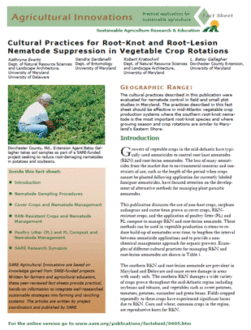With funding from Northeastern SARE, trials were conducted in small plots and on grower fields to evaluate cultural methods to manage RKN and root-lesion nematode. Meetings with Maryland and Delaware producers of potatoes and other vegetable crops led to the selection of 12 three-year rotational sequences for evaluation in small plots and six three-year rotations to evaluate on two farms in Dorchester County, Maryland. The experimental locations all were infested with RKN (Meloidogyne incognita) and root-lesion nematode (Pratylenchus penetrans). Experiments in small plots and on growers’ fields were arranged as a randomized complete block design with seven and four replications, respectively.
Early season sampling (i.e. April or May) was determined to be too early for detection of damaging levels of RKN or root-lesion nematode. Summer or early fall sampling dates effectively identified fields that exceeded threshold levels of the two nematodes.
The field and micro-plot experiments demonstrated that, while not consistent, RKN resistant soybean ‘Manokin’ or sorghum sudangrass grown annually as a green manure cover crop could reduce RKN compared to the control treatment of an RKN susceptible soybean. ‘Manokin’ or castor beans grown as a cover crop and incorporated as green manure reduced RKN by 60% or greater in the fall of 2000 and 2001. Sorghum sudangrass, which was grown as a cover crop and incorporated as green manure, reduced RKN by 50% or more in 2001. In addition to reductions in RKN in the soil, cucumber root-knot indices were reduced in 2001. This reduction occurred where sorghum sudangrass was grown and amended in the fall of 2000 with 2,500 lb/acre PL or 31,000 lb/acre PL compost.
Likewise, high rates of PL and PL compost alone or in combination with sorghum sudangrass also led to a reduction in root-lesion nematode – though not in all years. Reductions in root-lesion nematode were observed only in 2001 and when grain sorghum (with no amendment) or sorghum sudangrass amended with 2,500 to 7,300 lb/acre PL or with 10,500 to 31,000 lb/acre PL compost reduced root-lesion nematode by 70% or more compared to a grower standard treatment. However, the cover crop, PL or PL compost treatment effect generally did not carry over to the following year and therefore cover crop and PL and PL compost amendment needs to be included annually.
SARE Fact Sheet # 06AGI2005
